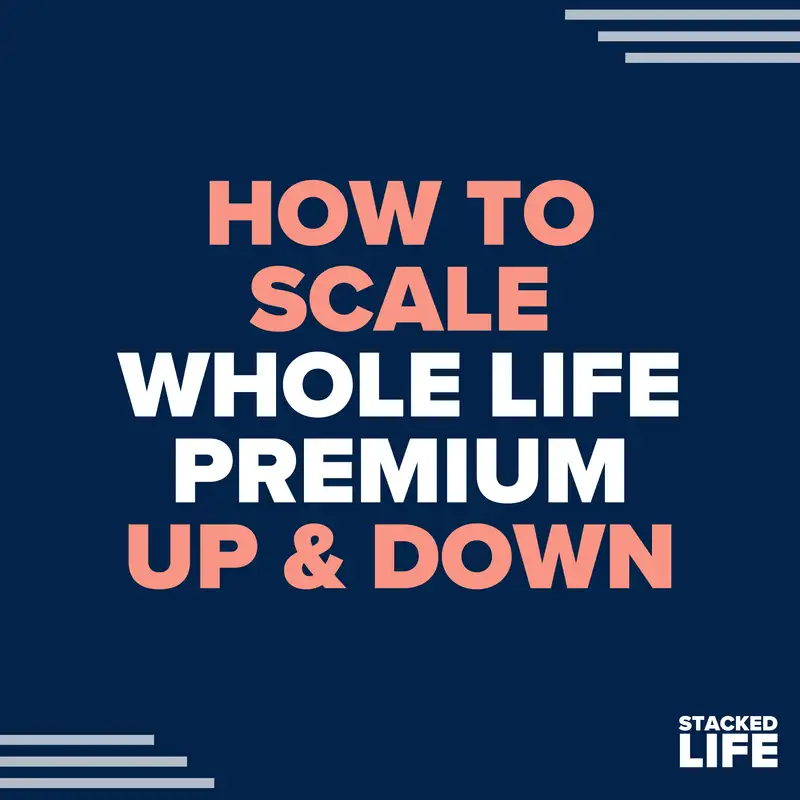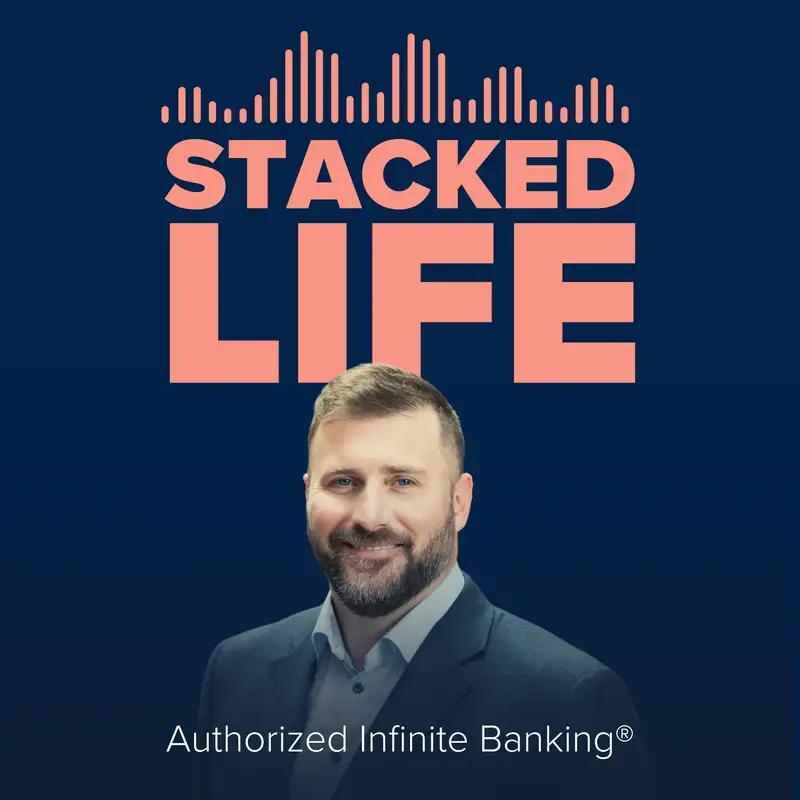17: How to Scale Your Premiums Up and Down
017 Flexible Premiums - Main Recording
===
John Perrings: [00:00:00] One of the top concerns people have about buying whole life insurance is the idea that you're kind of chained to paying this big premium forever. And I'm here to tell you that this fear is largely overblown. The reality is a whole life insurance policy, especially when designed for Infinite Banking, gives you a significant amount of control, allowing you to scale your.
Payments down when life happens, and just as, or even more importantly, scale your premiums up when opportunity knocks.
This is Stacked Life, the podcast that teaches you everything you need to know about The Infinite Banking Concept, whole life insurance, and the strategies that make it all work. And I'm John Perrings and authorized Infinite Banking practitioner.
I've implemented IBC for hundreds of my clients and educated thousands more with original content from my podcasts, articles, and courses at StackedLife.com.
By the end of this episode, you'll have a clear understanding of how whole life insurance premium flexibility works and have a real level of [00:01:00] comfort knowing you have several options. You'll learn about the built-in flexibility that allows you to scale your premiums down during a financial crunch, and just as importantly, scale them up to accelerate your wealth when you have profits or a windfall.
So here's what we'll cover.
Number one, how the Paid Up Additions or PUA rider is one of the main keys to premium flexibility. Number two, I'll share three ways you can pay less premium when you face a cash crunch, like a job loss or an unexpected expense.
Number three, the often overlooked but critical importance of also having the flexibility to pay _more _premium. Number four, why a balanced policy design gives you more control than a maxed out PUA policy. And finally, number five, how this flexibility ties directly into the core principles of The Infinite Banking Concept.
How I Have Used Whole Life Flexibility, Personally
---
John Perrings: This topic is a little bit personal for me because when I made a total career change from technology into the financial [00:02:00] services business. It took a while to get on my feet and start earning a predictable income. There were times when I had to borrow money from my policy to not only pay the premiums, but just to pay the bills, and I've seen it with my clients as well.
One client recently got laid off, took a policy loan to pay his full annual premium, and completely took that worry off the table for an entire year while he transitioned to a new job.
And I know the alternatives because if you've listened to the podcast at all, you know, I'm pretty open about the fact that I've made all the mistakes out there. I've made them myself, and it's one of the things that led me to this business. In the first 20 years of my career in the startup world, I was putting money into a 401k just like everyone else.
But when layoffs came around, which is common in the startup world, I'd have to liquidate it just to pay the bills, losing the growth on that money forever. When I eventually learned about Infinite Banking, having a whole life [00:03:00] policy finally put me in a position of control where I had cash and liquidity to roll with the punches without sacrificing the growth that I worked so hard for.
So let's get into the details around premium flexibility. There's a preconception out there that when you buy a whole life insurance policy, you're kind of locking yourself in into this big premium payment forever. And it's true, you're making a commitment, but it's not as rigid as it might sound.
Comparing Whole Life Insurance to Other Insurance
---
John Perrings: And just to add a little perspective first before we get into this, we should compare whole life insurance premiums to other insurance you're already paying for. If you think about your auto home or even your health insurance, which is insane, especially if you're on the California exchange like I am, those premiums tend to increase over time because they're always renewing and they're always subject to a lot of external factors.
Whole life insurance premiums, on the other hand, are predictable and locked in for the entire duration of the contract. [00:04:00] So even though the premium is locked in, you're locked into paying it, it's also locked in in a good way because it doesn't go up.
Setting the Stage for Flexibility
---
John Perrings: Now onto the flexibility, the core of real flexibility with whole life insurance, a lot of it comes from the Paid Up Additions Rider or the PUA rider. A PUA rider lets you buy small little chunks of life insurance that get kind of tacked onto the main policy. And these chunks are what are called "paid up," which means no future premiums are due to keep that portion of the death benefit. Because they're paid up, they have a higher present value, which is what creates more cash value in the early years of the policy. And this is where a little confusion comes in, because people tend to think that PUA just means cash value, like it's equal to cash value,
and that's not exactly true. So what I try to help people understand is that. Everything you pay is premium, whether it's base term rider premium or PUA premium. And a lot of people [00:05:00] kind of try to game the system by separating these in their mind. So the, the question I ask a lot of times is like, how much money do you want to start saving in a strategic manner?
And let's say that number is $2,000 a month just to use a number and you feel really comfortable with that. And we design a policy around that $2,000. That $2,000 is the total premium. Base term and PUA are all included in that $2,000 a month. To keep things simple. Let's take term out of the conversation for today and just focus on the base and the PUA.
If we had that policy, we might build it so that a thousand dollars is base premium and a thousand dollars is PUA premium. This would give you flexibility in both directions.
And I know there are some people out there whose ears are perking up right now listening for the ratio of base to PUA. I have a lot of other info about that, so please [00:06:00] just put the ratio stuff aside for now and focus on what this episode is about, which is flexibility, and I just wanna keep things simple.
Scale Down PUA Premium
---
John Perrings: If you face a cashflow crunch from a job loss or unexpected expense, you have a few ways to manage your premium payments.
The first thing you could do is just scale down or completely eliminate your PUA payment. This is probably the easiest method. You can call the insurance company and ask them to stop drafting the PUA portion of your premium.
You only have to pay the base premium to keep the policy inforce. The PUA is really an optional component.
Now for someone with a W2 job and a regular predictable income, I usually suggest having the PUA portion drafted automatically every month or included in your annual payment every year. Because, otherwise, it [00:07:00] sometimes doesn't end up getting paid. In that scenario, you just have to call the insurance company and ask that the PUA portion be reduced or stopped.
If you pay your premium annually, you can just opt to not pay the PUA portion. For me, I personally prefer to pay my premiums monthly. It just gives me a little more granular control over everything, and since my income is commission based, other people will be in the same scenarios if they're in sales.
Uh, my income is commission based and less predictable. I. All of my policies are set up only to auto draft the base premium portion. So then whenever I get a commission, I then, part of my process is to make a PUA payment as part of that commission right off the bat. So for me, when things get tight, I never even have to make a phone call.
I just don't pay the PUA for that month. So, you know, I'm just kind of making generalizations about how people pay. You pay however is best for you.
Now, there's something to be aware of here. [00:08:00] If you stop paying your PUA premium in the first, call it five years, it will have a more significant effect on your cash value growth because that PUA Rider is really doing most and even all of the heavy lifting for building cash value in the early years of that policy.
After around year five and you know, don't hold me to timeframes or anything like that because it really depends on age and health and all that. The base premium actually does more heavy lifting for building cash value.
And the reason I'm explaining this is so you understand that in a more mature policy, if you stop paying PUA, you will have less cash value simply because you're paying less premium, but the efficiency of the cash value is not affected because the base premium is just as efficient, maybe even more so by that time.
And I do want to say that it's not the end of the world if you have to scale back in the early years of the policy. I [00:09:00] just want to explain that it's an important trade off to be aware of.
Using Policy Loans to Pay Premium
---
John Perrings: The other way you can come out of pocket less money if you come across a tough month or a tough year, is you can use a policy loan.
If you're in a situation where paying even the base premium is a struggle, you can always use a policy loan to pay the base or the entire premium. As I mentioned, I've done this personally multiple times. And, you know, the thing is, this is the core idea of Infinite Banking. We're putting ourselves in a position of cash with a hundred percent control and liquidity over that cash.
And here's a key point that sometimes gets missed. When we use a policy loan for whatever the reason, whether it's to buy something or invest in something or to pay our premium, we never lose the growth on our cash value. And if you compare this to the sad state of affairs I was in before, having to
cash out my 401k or some other type of growth [00:10:00] asset where you lose the growth forever. It's a pretty big deal. Most people don't only own life insurance, they have other investments, and when you have the ability to lean on your cash value, you can leave your other investments completely alone. And this allows you to handle the bumps in the road without liquidating assets.
So you never lose the growth on your cash value and you never lose the growth on your other investments.
Premium Offsets to Pay Premium
---
John Perrings: The last way I'll mention if you have a tough month or a tough year, you can also do what's called a premium offset. You can offset your premium using the policies dividend for the year, or by surrendering previously purchased, Paid Up Additions. Now nothing is free, and when you do this, you don't accrue a loan balance like you do when you use a policy loan, but there's still a cost.
You either reduce your death benefit or you reduce the growth on your cash value. You don't lose any cash value, but it does slow the growth if the dividend's being used to pay the annual premium [00:11:00] as opposed to going to grow the existing cash value by buying more Paid Up Additions on top of the out-of-pocket premium.
So there's always a trade off, but these are just different tools available to you when the time arises.
Now, here's the thing I, I really want to talk about.
Scale Up PUA Premium Payments to Accelerate Growth
---
John Perrings: How can you pay more premium when times are good? Having the flexibility to pay more is also important. This is a side of the coin that I think gets critically ignored.
People get so focused on the fear of paying the premium that they forget what Nelson Nash talked about in his book, _Becoming Your Own Banker._ He said, "don't be afraid to capitalize," which means don't be afraid to pay a premium. You know, statistically it's far more likely you'll need the ability to scale up than it is needing to scale down.
With close to, like, a hundred percent certainty during your working years especially, and likely beyond.
Balanced Policy Design vs. Maxed Out PUA
---
John Perrings: If you're doing anything with your money, your system is going to need to expand, and this is where I [00:12:00] think the max funded PUA strategy falls apart. You know, a lot of agents talk about designing policies with like 80, 90% PUA because it creates more cash value in the first years, and that's true. But what they're missing is that you can never pay a higher premium.
You can never pay more than that because it's already maxed out. Unless you are okay with MECing the policy and making it taxable. If you get a bonus or a windfall or even just regular profits from an investment, you have nowhere to put it with a maxed out PUA policy.
If you think about this, if we're truly wanting to "become our own banker," and take over the banking function, and we're deploying capital via policy loans to create a profit, what happens to that profit? If you can't put that profit back into your system? Are you really being fully strategic or are you only being half strategic?
Right? With a balanced design, you have room to [00:13:00] expand. You can take that bonus, or you can take that profit and pour it back into your policy via PUA payments, making the whole system bigger and better over the long term. The idea that you can just buy another policy is a gamble, because we don't know if you'll be insurable in the future.
It is not that hard to become uninsurable. A balanced policy gives you the ability to expand within the same contract.
Here's the thing. Infinite Banking is a process, not a product. It's not a race to the highest cash value in year one. It's about having control over your capital. And a policy that's over-stuffed with PUA in the first year is not only fragile because these designs by far have way higher lapse rates, but you also give up the flexibility to expand your system.
True control is having flexibility in all directions.
Alright.
Conclusion and Next Steps
---
John Perrings: I hope this was helpful information for you. If any of these principles and ideas are resonating with [00:14:00] you and you'd like to learn how they might work in your life, schedule a free consultation with me. I'll take you through a short exercise to determine if IBC would be a good fit for what you want to accomplish.
And if so, what your next best financial move would be. Head over to StackedLife.com and schedule a consultation with me right there. Thanks, and I'll see you on the next one.
Creators and Guests


